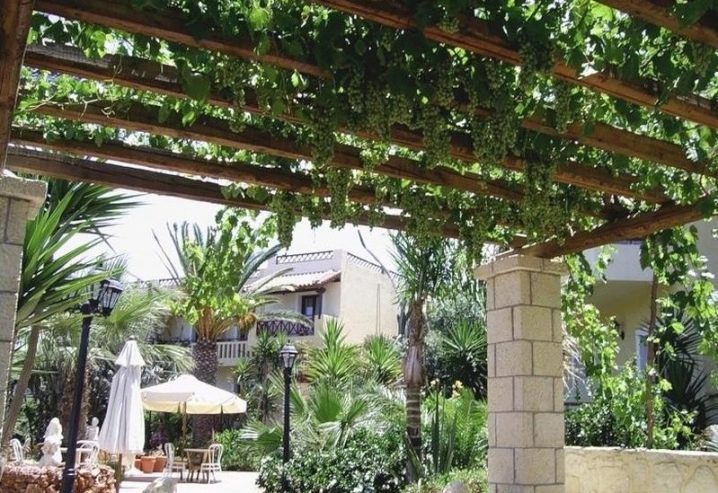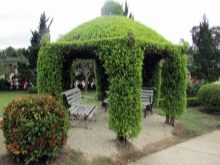Beautiful options for grape arbors

The grape gazebo on the plot is an amazingly beautiful structure. The frame for it is easy to build, it is inexpensive, the result is visible already in the first season. A light and simple canopy can be assembled at the entrance to the house. But real aesthetes create vine arches, galleries, green rooms, fairy-tale houses or whole labyrinths on their site. If the buildings are decorated with a top green covering, they play the role of beautiful shady gazebos.

Views
Gazebos are divided into seasonal, which are collected in the warm season and hidden in the winter, and stationary, built thoroughly for any season. The former are equipped with plants in pots and flowerpots, the latter are landscaped with perennial grapes and other types of climbing plants. Stationary buildings are beautiful and varied. Their frames have different textures. They can be made of metal, stone, brick or wood, they can contain combined building materials.
You should be aware that wood is not very suitable for creating grape gazebos. Some species of this plant live up to 200 years. The tree, exposed to moisture from watering, will rot much earlier. But the beauty and ecological purity of this material attracts many who prefer it.
Starting the construction of a gazebo, you need to know for what purposes it will serve, what functions it will perform.


A resting gazebo can be hipped, domed. If a vacation is planned with a barbecue and friends, the dimensions of the building are assumed to be voluminous and capital. According to fire safety standards, such a gazebo should stand at a distance of six meters from any buildings. It can be square, rectangular, multifaceted or indefinite. The gazebo next to the building usually serves as a shady shelter at the entrance to the house. It is quite budgetary, since it requires the construction of only one wall and a top covering.
Miniature gazebos are installed in gardens to decorate the landscape as an addition to decorative streams and fountains. A gazebo for a cozy rest is arranged in a shady corner of the garden. At higher elevations, an aerial structure is usually used, resembling an observation deck. The variety of types lies in the geometry of the structure.
They can be round, domed, multifaceted, arched, square, irregular in shape, facing the building, pergolas, trellises under a canopy.



Arch
The arched forms of the arched structure, if mounted correctly, without distortions and deformation, look very attractive.
To create an arch, you will need to do the following:
- for a green arched gazebo, the frame is assembled from metal rods;
- it is necessary to prepare concrete, gravel or broken brick, as well as thick wire;
- dig holes, lay gravel on the bottom;
- the rods are bent with an arc, the ends are inserted into the prepared pits and poured with cement, creating the basis of the arched frame;
- for the strength of the structure, several transverse rods are mounted by welding;
- the rest of the horizontal fasteners are formed using strong wire.



Trellis structure with a canopy
This type of gazebo is made from fittings, pipes or wood.
The following algorithm should be followed:
- mark and dig holes in which the supports are installed;
- the racks are poured with cement;
- vertical and horizontal fasteners are mounted between the supports, creating a grape lattice;
- the roof is formed in the same way, it can be made flat or inclined towards the sun; sometimes a continuous covering (canopy) is built to protect from rain;
- to create an ideal design, vertical supports are checked with a plumb line, and horizontal fasteners - with a level;
- it should be borne in mind that too high a gazebo is difficult to maintain; to form shoots, you will have to get to the top cover.


Rounded varieties
Such a structure will decorate even a small courtyard.
To create such a structure, you should perform such actions as:
- supports made of pipes or wooden beams are installed in the prepared pits in a clearly delineated circle;
- from the intended side, leave the entrance to the gazebo;
- at the top of the circle, a solid base is mounted, to which the conditional roof will be attached; the rods are tilted with one end connected to the base, the second - they are collected at the top point;
- it is not difficult to form a green gazebo of this design - two vines are planted at the entrance from both sides, young shoots are directed around the circumference and slightly upward;
- forming a gazebo, shoots must be tied up and excess growth must be removed; If you do everything right, grapes are able to surround the building in one season, you get a pretty fairy-tale house with a domed top.


Building attached to the house
This is the most popular type of green construction, which is often installed from the gate to the porch of the house.
The gazebo attached to the house has the following features:
- one side of the gazebo is the building itself, to which it is mounted; the green building looks like one wall and a top covering;
- under the canopy of such gazebos, there is usually enough space for a garden table with armchairs, a hammock or a swing bench;
- grape greens can be diluted with bright flowers suspended in pots at the entrance to the house;
- grapes will develop more actively if the gazebo is on the south side.


Multifaceted and irregularly shaped buildings
Beautiful designs of irregular shape, created by the designer, fascinate with an extraordinary look. Irregularly shaped structures fill well isolated, unsuitable for use places on the site. But they can also be built on a sunny flat surface at any scale, guided by non-standard solutions of the designer. You can assemble a multifaceted structure with your own hands, you just need to "be friends" with a plumb line and level. With these tools, the edges are balanced and measured.


Multifaceted or irregular shapes can afford large, solid buildings that require a certain cost.
When erecting such structures, it is worth considering the following nuances:
- such gazebos need a project where the location of the future structure, its shape, size, material and style are noted; the varieties of planted plants are taken into account, as well as an approximate cost estimate;
- when building a large gazebo, it should be remembered that it will definitely cast a shadow, so its location should not interfere with neighbors or other buildings;
- capital structures need a foundation, and which one to choose (tape, pile or columnar) depends on the massiveness of the building; in any case, concrete, sand and gravel should be prepared;
- such gazebos have a solid lower part of the walls, from fifty to one hundred centimeters high; their height should protect the sitting person from drafts, but not interfere with the view;
- the deaf lower part of the wall can be laid out of brick, stone, or use logs, boards, lining; it is necessary that the selected material matches the style and harmonizes with the surrounding space;

- waterproof material is used to create the floor, since precipitation will fall into a half-open gazebo; it can be stone, ceramic tiles or materials with water-repellent impregnations;
- the gazebo, which provides for a stove, barbecue, grill, barbecue, should be positioned so that the grapes do not suffer from high temperatures; in such cases, the wind rose is taken into account, the stove is installed against a blank wall at a standard distance from the grape bushes;
- the variety of the ornamental plant must be frost-resistant; sometimes even such varieties, preparing for winter, have to be dug in, it all depends on the climatic conditions of the region;
- if the structure is too capital, it may have to be registered with the administration.

Gazebo grapes
Grapes are a beautiful and healthy perennial plant that can turn even an unsightly gazebo into a fabulous house. It will not only create a thick shade for 1-2 seasons, but will also delight you with a juicy tasty berry. The gazebo is formed already in the first year after planting the seedlings. The first fruiting is expected in the second year. Plants that are 4–5 years old can be considered adults.


How to plant the vine correctly?
The number of seedlings around the gazebo will depend on the grape variety and the size of the building. Sometimes two bushes are enough at the entrance of a round building. If the gazebo is square, one plant is planted at each of the four supports. Cuttings are planted along the perimeter of a large gazebo every two meters.
Planting a vine includes the following stages:
- to plant the shoots, dig holes half a meter deep, stepping back from the frame by 20-30 cm;
- at the bottom of each hole, drainage should be made from gravel or other stones;
- the soil selected from the hole must be mixed with fertilizer, sand and compost; half of the pits should be filled with the finished mixture;
- place the cutting in a hole with a guiding slope and carefully fill it with the remaining mixture of soil and fertilizers;
- form a mound with a depression for watering and actively water the plant;
- tie the seedling to the horizontal bottom row of the grape net.



Formation of greenery
One of the ways to form a gazebo is called a fan cordon, when the plant is directed not upward, but into the girth of the building. From the lignified bunch, fruit vines diverge in different directions, forming a so-called fan. Large sleeves are created, with a length of one and a half meters. The fan-shaped method can be non-stem or with the release of the stem. The gazebos have more than four arms, on which fruit links are formed every half a meter. Cutting off young shoots, the sleeves remain unchanged, they are renewed only in case of winter damage.
The most popular type of grape arbor formation is a high-standard vertical cordon. Grapes cultivated in this way develop quickly and produce a rich harvest. The disadvantage of this method is the lack of vegetation in the lower part of the gazebo. They correct the situation with shrubs planted around the building. But you can form a high gazebo in an integrated way: vertical and fan cordon at the same time.



It is worth considering in more detail how to form a gazebo with a vertical cordon.
- Often, the structure is actively overgrown with shoots already in the first year. But if the vines at this stage have not acquired the desired size, the strongest of them should be chosen and shortened in the place where the vine has reached a diameter of 1.5 cm. The eyes, with the exception of the two upper ones, should be removed and treated with paraffin. The shoot chosen for the trunk must be shortened, which will give it the strength to grow and get stronger.
- Over time, when the bole reaches the roof, only the top three eyes are left, the rest are removed without regret. Those vines that were formed (except for the trunk) on their own must be tied up, directing them horizontally in different directions. The next year, the three buds left from the stem will give vines with the first grape harvest.
- In the fall, after picking the berries, it is necessary to cut off the topmost vine with a piece of the woody part, and distribute the rest over the roof, spreading them in different directions (sleeves are formed). Autumn pruning of these shoots should be up to a diameter of 1.5 cm.
- Both sleeves, carefully bending, are attached to the roof surface in increments of 1 m. This is how the foundation of the future green gazebo is laid.



The final stage of gardening the gazebo will depend on the goals set. If the climate of the region allows you not to cover the bushes of grapes, you can choose a vertical cordon. In this case, a tall stem with magnificently hanging shoots is also suitable. In cold regions where it is necessary to shelter plants, you can use a standard option or a standard fan cordon. For the dining method, a low stem with a vine is formed, which is easy to prepare for a winter shelter.

We select the right varieties
Not every type of grape is suitable for creating a beautiful, well-formed gazebo. We need frost-resistant, fast-growing, voluminous varieties. The Wild Maiden grape is a favorite decorative variety among many summer residents. This is a great solution if there is no need for berries. It is unpretentious, easy to care for and very beautiful. One plant can cover an area of up to 20 square meters. It can easily climb without trellises on brick and masonry to a height of 15 meters. Oblong carved green leaves in the fall light up scarlet, crimson, purple.
Of the fruiting arbor species, the actively growing Amur varieties are frost-resistant (they can withstand frosts down to -30 degrees). Fruits with a pronounced taste. They are unpretentious in care, with strong development and pleasant taste qualities - these are Lydia, Valiant, Alpha, Concord, Isabella. The bushes are undemanding to the abundance of the sun, they tolerate shade well. The versatile table varieties that give a bountiful harvest have proven themselves excellently - these are Prairie Star, Victoria, St. Croix, Timur. They are frost-resistant, but need shelter in some regions.



How to choose and fix grapes for the gazebo, you will learn in the next video.













The comment was sent successfully.